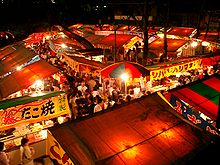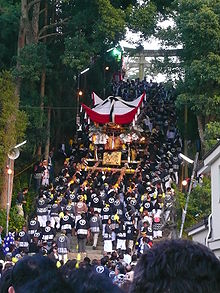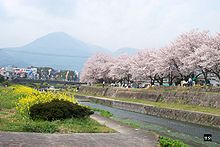- Japanese festivals
-
"Matsuri" redirects here. For other uses, see Matsuri (disambiguation).
Shinto 
This article is part of a series on ShintoPractices and beliefs Kami · Ritual purity · Polytheism · Animism · Japanese festivals · Mythology · Shinto shrines List of Shinto shrines · Twenty-Two Shrines · Modern system of ranked Shinto Shrines · Association of Shinto Shrines Notable Kami Amaterasu · Sarutahiko · Ame no Uzume · Inari · Izanagi · Izanami · Susanoo · Tsukuyomi Important literature Kojiki · Nihon Shoki · Fudoki · Rikkokushi · Shoku Nihongi · Jinnō Shōtōki · Kujiki See also Religion in Japan · Glossary of Shinto · List of Shinto divinities · Sacred objects · Japanese Buddhism · Mythical creatures
Shinto Portal
Japanese festivals are traditional festive occasions. Some festivals have their roots in Chinese festivals but have undergone dramatic changes as they mixed with local customs.
Some are so different that they do not even remotely resemble the original festival despite sharing the same name and date. There are also various local festivals (e.g. Tobata Gion) that are mostly unknown outside a given prefecture. It is commonly said that you will always find a festival somewhere in Japan.
Unlike most people in East Asia, Japanese people generally do not celebrate Chinese New Year (it having been supplanted by the Western New Year's Day in the late 19th century); although Chinese residents in Japan still do. In Yokohama Chinatown, Japan's biggest Chinatown, tourists from all over Japan come to enjoy the festival. And similarly the Nagasaki Lantern Festival[1] is based in Nagasaki's Chinatown. See: Japanese New Year.
Events within festivals
Festivals are often based around one or two main events, with food stalls, entertainment, and carnival games to keep people entertained. Some are based around temples or shrines, others hanabi (Fireworks), and still others around contests where the participants sport loin cloths (see: Hadaka Matsuri).
Local festivals (matsuri)
Big Mikoshi "Yatai" Parade In Miki, Hyogo, Japan
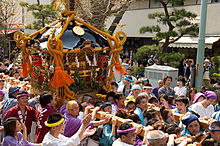 Mikoshi Parade In Kamakura Japan 2007
Mikoshi Parade In Kamakura Japan 2007
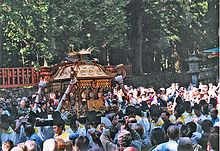 This mikoshi enshrines Tokugawa Ieyasu at the Tōshō-gū in Nikkō. Participants carry the mikoshi during the spring and autumn matsuri of the shrine
This mikoshi enshrines Tokugawa Ieyasu at the Tōshō-gū in Nikkō. Participants carry the mikoshi during the spring and autumn matsuri of the shrine
Matsuri (祭) is the Japanese word for a festival or holiday. In Japan, festivals are usually sponsored by a local shrine or temple, though they can be secular.
There are no specific matsuri days for all of Japan; dates vary from area to area, and even within a specific area, but festival days do tend to cluster around traditional holidays such as Setsubun or Obon. Almost every locale has at least one matsuri in late summer/early autumn, usually related to the rice harvest.
Notable matsuri often feature processions which may include elaborate floats. Preparation for these processions is usually organized at the level of neighborhoods, or machi. Prior to these, the local kami may be ritually installed in mikoshi and paraded through the streets.
One can always find in the vicinity of a matsuri booths selling souvenirs and food such as takoyaki, and games, such as Goldfish scooping. Karaoke contests, sumo matches, and other forms of entertainment are often organized in conjunction with matsuri. If the festival is next to a lake, renting a boat is also an attraction.
Favorite elements of the most popular matsuri, such as the Nada Kenka Matsuri of Himeji or the Neputa Matsuri of Hirosaki, are often broadcast on television for the entire nation to enjoy.
List of famous matsuri
Name Matsuri Note Place Atsuta held at Atsuta Shrine in June Nagoya Aoi Kyoto Gion Kyoto Hadaka Okayama Hōnen held at Tagata Shrine in March Komaki Jidai Kyoto Kanamara Kawasaki Kanda Tokyo Kanto[citation needed] held in 3 to 7 August Akita Nagoya held in Hisaya Ōdori Park in Sakae, Nagoya Nagoya Sanja Tokyo Sannō Tokyo Tenjin Osaka Sapporo Snow Festival (Hokkaido)
Sapporo Yuki Matsuri is one of the largest festivals of the year in Sapporo, held in February for one week. It began in 1950 when high school students built snow statues in Odori Park, central Sapporo. The event is now very large and commercialized. About a dozen large sculptures are built for the festival along with around 100 smaller snow and ice sculptures. Several concerts and other events are also held.
Lake Shikotsu Ice Festival
Lake Shikotsu is the northernmost ice-free lake which is 363 meters deep. This festival features a moss-covered cave, which has evergreen draped on the inside and is covered in ice (Gianola, 2008). This festival is held from late January to mid February. This festival features ice sculptures, small and large. At night the sculptures are illuminated by different colored lights. There is a fireworks show during the festival as well. Admission is free. Amasake (hot sake) is available for purchase to enjoy (2008 Ministry of Land).
Lake Towada Snow Festival
This lake festival is held in the beginning of February. Held in the town of Yasumiya, this festival is on the south side of lake Towada (near the wooden statues). This festival is open all day, but at 5pm one can enjoy activities such as going through a snow maze, exploring a Japanese igloo, and eat foods from Aomori and Akita prefectures. There is a fireworks show and events held on an ice stage.
Aomori Nebuta Festival
This festival is held annually and features colorful lantern floats called nebuta which are pulled through the streets of Central Aomori. This festival is held from about August 2-7 every year. This event attracts millions of visitors. During this festival, 20 large nebuta floats are paraded through the streets near Aomori JR rail station. These floats are constructed of wooden bases and metal frames. Japanese papers, called washi, are painted onto the frames. These amazing floats are finished off with the historical figures or kabuki being painted on the paper. These floats can take up to a year to complete. There is a dance portion of this festival. There are haneto dancers and they wear special costumes for this dance. Everyone is welcome to purchase their own haneto costume that they may too join in on the fun (Mishima, Aomori Nebuta Festival).
Nango Summer Jazz Festival
This event is held every year. Thousands of artists from all over Tohoku and even further regions come to Nango to perform. This is the largest open-air jazz concert held in Tohoku region. This festival began in 1989, in a small venue indoors. There was such a large response from the fans that is was expanded into a large annual festival. One must purchase tickets for this event (Bernard, 2007).
Cherry blossom festivals
Japan celebrates the entire season of the cherry blossoms. All over Japan festivals are held and include food and at night beautiful lanterns. An interesting fact concerning cherry blossoms:
- According to a study, plants in urban areas have plants that bloom are blooming faster. From evidence at a cherry arboretum at Mt. Takao, early flowering of the cherry blossoms is happening due to the larger response to temperature variation (Primack, Higuchi, & Miller-Rushing, 2009).
Some locations of cherry blossom festivals include:
- Yaedake Cherry Blossom Festival in Okinawa. This festival takes place from late January – mid February
- Matsuyama Shiroyama Koen Cherry Blossom Festival in Matsuyama-city, Ehime. This festival takes place early April.
- Matsue Jozan Koen Festival in Matsue-city, Shimane. This festival has a feature of illuminating the cherry blossom trees at night. This festival takes place late March-early April.
- Tsuyama Kakuzan Koen Cherry Blossom Festival in Tsuyama-city, Okayama. Japanese tea ceremonies and music performers are held at these festivals. This festival is held early-mid April.
- Takato Joshi Koen Cherry Blossom Festival in Takato-machi Ina-city, Nagano prefecture. The trees in this region have pink blossoms. This festival is held early April.
- Takada Koen Cherry Blossom Festival in Joetsu-city, Niigata prefecture. This festival is held early-mid April.
- Kitakami Tenshochi Cherry Blossom Festival in Kitakami-city, Iwate. This festival is held mid April-early May.
- Hirosaki Cherry Blossom Festival held in Hirosaki Koen Hirosaki-city, Aomori prefecture. This festival is held late April-early May (Mishima, Cherry Blossom Festivals 2010).
Hadaka Matsuri
The origins of Hadaka Matsuri date back 500 years when worshippers competed to receive paper talismans called Go-o thrown by the priest. These paper talismans were tokens of the completion of New Year ascetic training by the priests. As those people receiving these paper talismans had good things happen to them, the number of people requesting them increased year by year. However, as paper was easily torn, the talismans were changed to the wooden ofuda that we know today.
Naoi-shinji, also known as "Hadaka Matsuri (naked festival)", started in the year 767 AD, the Nara Period. This rite was founded on the fact that the governor of Owari Province (presently Aichi Pref.) visited the Owari Shosha Shrine ( Konomiya shrine ) to drive away evil spirits and calamities, because Emperor Shotoku ordered all the kokubun-ji* to offer invocations to dispel plagues.
It is said that the form of the festival, a struggle to touch the Naoinin or Shin-otoko (man of god), is reminiscent of the struggle in old times between the assemblage of lower-ranking shinto priests called shanin and contributors tried to catch and set up a man for naoinin (shin-otoko), an unlucky poor man, who was unwilling to take the role.
Nationwide festivals
Fixed days
- Seijin Shiki: Coming of Age Day (second Monday of January)
- Hinamatsuri: Doll Festival (March 3)
- Hanami: Flower Viewing (late March to early April)
- Tanabata: star festival (July 7)
- Shichi-Go-San: festival day for children aged three, five and seven (November 15)
- Ōmisoka: New Year's Eve (December 31)
Multiple days
- Setsubun: division of season (beginning of each of the four seasons) (Feb. 3 )
- Ennichi: temple fair (holy days related to Kami and/or Buddha)
Bunkasai
New Year (正月 Shōgatsu))
Date: 1–3 of January (related celebrations take place throughout January)
Other Names: Oshōgatsu (O is an honorific prefix)
Information: New Year observances are the most elaborate of Japan's annual events. Before the New Year, homes are cleaned, debts are paid off, and osechi (food in lacquered trays for the New Year) is prepared or bought. Osechi foods are traditional foods which are chosen for their lucky colors, shapes, or lucky-sounding names in hopes of obtaining good luck in various areas of life during the new year. Homes are decorated and the holidays are celebrated by family gatherings, visits to temples or shrines, and formal calls on relatives and friends. The first day of the year (ganjitsu) is usually spent with members of the family.
People try to stay awake and eat toshikoshisoba, noodles to be eaten at midnight. People also visit Buddhist temples and Shinto shrines. Traditionally[citation needed] three are visited. This is called sansha-mairi. In the Imperial Palace at dawn on the 1st, the Emperor performs the rite of shihōhai (worship of the four quarters), in which he offers prayers for the well-being of the nation. On January 2 the public is allowed to enter the inner palace grounds; the only other day this is possible is the Emperor's birthday (December 23). On the 2nd and 3rd days acquaintances visit one another to extend greetings (nenshi) and sip otoso (a spiced rice wine). Some games played at New Year's are karuta (a card game), hanetsuki (similar to badminton), tako age (kiteflying), and komamawashi (spinning tops). These games are played to bring more luck for the year. Exchanging New Year's greeting cards (similar to Christmas Cards ) is another important Japanese custom. Also special allowances are given to children, which are called otoshidama. They also decorate their entrances with kagami mochi (two mochi rice balls placed one on top of the other, with a tangerine on top), and kadomatsu (pine tree decorations).
A later New Year's celebration, Koshōgatsu, literally means "Small New Year" and starts with the first full moon of the year (around January 15). The main events of Koshōgatsu are rites and practices praying for a bountiful harvest.
Doll Festival (雛祭り)
Date: March 3
Other Names: Sangatsu Sekku (3rd month Festival), Momo Sekku (Peach Festival), Joshi no Sekku (Girls' Festival)
Information: This is the day families pray for the happiness and prosperity of their girls and to help ensure that they grow up healthy and beautiful. The celebration takes place both inside the home and at the seashore. Both parts are meant to ward off evil spirits from girls. Young girls put on their best kimonos and visit their friends' homes. Tiered platforms for hina ningyō (hina dolls; a set of dolls representing the emperor, empress, attendants, and musicians in ancient court dress) are set up in the home, and the family celebrates with a special meal of hishimochi (diamond-shaped rice cakes) and shirozake (rice malt with sake).
Hanami (花見)
Date: April
Other Names: Hanami (flower viewing), Cherry Blossom Festival
Information: Various flower festivals are held at Shinto shrines during the month of April. Excursions and picnics for enjoying flowers, particularly cherry blossoms are also common, as well as many drinking parties often to be seen in and around auspicious parks and buildings. In some areas the peach blossom, the traditional flower of Japan (the Cherry being a symbol from the Edo period symbolising the Samurai culture), is viewed as well though this flowers earlier than the Cherry. In some places flower viewing parties are held on traditionally fixed dates. This is one of the most popular events during spring. The subject of flower viewing has long held an important place in literature, dance and the fine arts. Ikebana (flower arrangement) is also a popular part of Japanese culture and is still practiced by many people today. Some main things people do during this event are: games, folk songs, folk dance, flower displays, rides, parades, concerts, kimono shows, booths with food and other things, beauty pageant, and religious ceremonies. Families go out during weekends to see the cherry blossoms, and participate in the many festivals and activities.
Children's Day (子供の日 Kodomo-no-hi)
Date: May 5
Other Names: Iris Festival (菖蒲の節句 Shōbu no Sekku), Tango Festival (端午の節句 Tango no Sekku)
Information: May is the month of the Iris Festival. The tall-stemmed Japanese iris is a symbolic flower. Its long, narrow leaves resemble the sharp blades off a sword, and for many centuries it has been the custom to place iris leaves in a boy's bath to give him a martial spirit. Originally May 5 was a festival for boys corresponding to the Doll Festival, for girls, but in 1948 it was renamed Children's Day, and made a national holiday. However, this might be a misnomer; the symbols of courage and strength mainly honor boys. It is customary on this day for families with male children to fly koinobori (carp streamers, a symbol of success) outside the house, display warrior dolls (musha ningyō) inside, and eat chimaki (rice cakes wrapped in cogan grass or bamboo leaves) and kashiwamochi (rice cakes filled with bean paste and wrapped in oak leaves).
Tanabata (七夕)
Date: July 7
Other Names: The Star Festival
Information: It originated from a Chinese folk legend concerning two stars-the Weaver Star (Vega) and the Cowherd Star (Altair)-who were said to be lovers who could meet only once a year on the 7th night of the 7th month provided it didn't rain and flood the Milky Way. It was named Tanabata after a weaving maiden from a Japanese legend, named Orihime who was believed to make clothes for the gods. People often write wishes and romantic aspirations on long, narrow strips of coloured paper and hang them on bamboo branches along with other small ornaments.Bon Festival (盆 bon)
Date: 13–15 August
Other Names: urabon (盂蘭盆)
Information: A Buddhist observance honoring the spirits of ancestors. Usually a "spirit altar" (shōryōdana) is set up in front of the Butsudan (buddhist family altar) to welcome the ancestors' souls. A priest is usually asked to come and read a sutra (tanagyō). Among the traditional preparations for the ancestors' return are the cleaning of grave sites and preparing a path from them to the house and the provision of straw horses or oxen for the ancestors' transportation. The welcoming fire (mukaebi) built on the 13th and the send-off fire (okuribi) built on the 16th are intended to light the path.
Lantern Floating (灯篭流し Tōrō Nagashi)
Date: 15th or 16 July (August)
Information: The customary practice to mark the end of the Bon Festival. Small paper lanterns containing lit candles are set afloat on rivers or the sea light the way for the ancestral spirits as they depart. Usually a message is written on the outside of the paper lantern.
"7-5-3" Festival (七五三 Shichigosan)
Date: November 15
Information: Five-year-old boys and seven- or three-year-old girls are taken to the local shrine to pray for their safe and healthy future. This festival started because of the belief that children of certain ages were especially prone to bad luck and hence in need of divine protection. Children are usually dressed in traditional clothing for the occasion and after visiting the shrine many people buy chitose-ame ("thousand-year candy") sold at the shrine.
Preparation for the New Year and Year-end fair
Date: late December
Other Names: Year-end (年の瀬 toshi no se),Year-end Fair (年の市 Toshi no Ichi)
Information: Preparations for seeing in the new year were originally undertaken to greet the toshigami, or deity of the incoming year. These began on the 13th of December, when the house was given a thorough cleaning; the date is usually nearer the end of the month now. The house is then decorated in the traditional fashion: A sacred rope of straw (shimenawa) with dangling white paper strips (shide) is hung over the front door to prevent evil spirits from entering and to show the presence of the toshigami. It is also customary to place kadomatsu, an arrangement of tree sprigs, beside the entrance way. A special altar, known as toshidana ("year shelf"), is piled high with kagamimochi (flat, round rice cakes), sake (rice wine), persimmons, and other foods in honor of the toshigami. A fair is traditionally held in late December at shrines, temples or in local neighborhoods. This is in preparation for the new year holidays. Decorations and sundry goods are sold at the fair. Originally these year-end fairs provided opportunities for farmers, fisherfolk and mountain dwellers to exchange goods and buy clothes and other necessities for the coming year.
Ōmisoka (大晦日 Ōmisoka)
Date: December 31
Information: People do the general house cleaning (Ōsōji) to welcome coming year and not to keep having impure influences. Many people visit Buddhist temples to hear the temple bells rung 108 times at midnight (joya no kane). This is to announce the passing of the old year and the coming of the new. The reason they are rung 108 times is because of the Buddhist belief that human beings are plagued by 108 earthly desires or passions (bonnō). With each ring one desire is dispelled. It is also a custom to eat toshikoshi-soba in the hope that one's family fortunes will extend like the long noodles.
See also
- List of festivals in Japan
- Culture of Japan
- Naked festival
- Japanese calendar
- Subaru Cherry Blossom Festival of Greater Philadelphia
- National Cherry Blossom Festival, Washington, D.C.
References
References
- mothra.rerf.or.jp::hiroshima::about matsuri an external article covering the topic
- Matsuri Food an article about the various foods available at most matsuri
- 2008 Ministry of Land, I. T. (n.d.). 2008 Chitose-Lake Shikotsu Ice Festival. Retrieved August 6, 2009, from Yokoso! Japan Weeks: http://www.yjw2008.jp/eng/info.php?no=241
- Bernard, S. (2007, July 11). Nango Holds Summer Jazz Festival. Retrieved August 9, 2009, from About.com: http://www.misawa.af.mil/news/story_print.asp?id=123060239
- Gianola, D. (2008, February 3). Chitose Lake Shikotsu Ice Festival. Retrieved August 6, 2009, from VR Mag: http://www.vrmag.org/issue29/CHITOSE_LAKE_SHIKOTSU_ICE_FESTIVAL.html
- Japan-Guide.com. (n.d.). Sapporo Snow Festival. Retrieved August 6, 2009, from Japan-Guide.com: http://www.japan-guide.com/e/e5311.html
- MisawaJapan.com. (n.d.). Lake Towada Winter Festival. Retrieved August 6, 2009, from MisawaJapan.com: http://www.misawajapan.com/festivals/others/towada_winter.asp
- Mishima, S. (n.d.). Aomori Nebuta Festival. Retrieved August 9, 2009, from About.com: http://gojapan.about.com/cs/tohokuregion1/a/aomorinebuta.htm
- Mishima, S. (n.d.). Cherry Blossom Festivals 2010. Retrieved August 9, 2009, from About.com: http://gojapan.about.com/cs/cherryblossoms/a/sakurafestival.htm
- Primack, R., Higuchi, H., & Miller-Rushing, A. (2009, September). The impact of climate change on cherry trees and other species in Japan. Retrieved August 9, 2009, from EBSCO Host: http://web.ebscohost.com.ezproxy.umuc.edu/ehost/detail?vid=4&hid=2&sid=9ce9efca-4e6d-4702-afff-8d9e8f3c8425%40sessionmgr11&bdata=JmxvZ2lucGFnZT1sb2dpbi5hc3Amc2l0ZT1laG9zdC1saXZlJnNjb3BlPXNpdGU%3d#db=a9h&AN=43528180
External links
- Official sites
- Festivals all over Japan—Japan Atlas
- Japan National Tourist Organization (photo library)
- Matsuri sites
- Private initiative sites/galleries
- JCITI.COM about Nagoya, see festivals section.
- Reggie.net—photographs of Neputa floats in Hirosaki.
- Description of the Odawara Omatsuri festival—archived.
- The Digital Matsuri Project—Japanese festival videos
Categories:- Festivals in Japan
- Shinto
- Japanese culture
Wikimedia Foundation. 2010.

